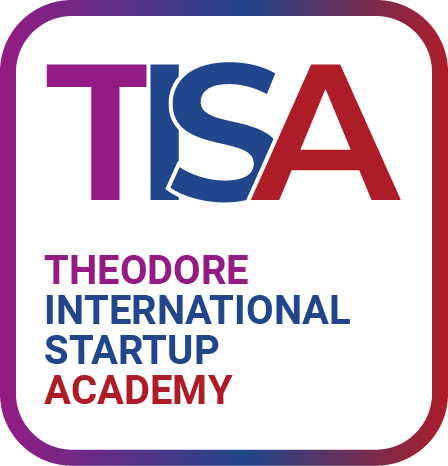LEARNING AT TISA
PROFESSIONAL TRACKS
PROFESSIONAL TRACKS
We offer a unique opportunity to start developing professional competencies from an early age:
- Students attend workshops on various topics and choose a professional track (STEM or CAD);
- We design an individual educational path for each student based on interests, talent, and needs;
- Students enroll in the track and start attending special classes. We bind subjects in the track to develop skills and competencies:
- TRACK 1 — STEMScience, Robotics, 3D Modeling and Prototyping, Programming, Inventor Lab, Advanced Math
- TRACK 2 — CADArts, Music (Choir, Solfedjio, Instrument), Graphic Design, Industry Design, Creative Writing, Drama
TRACKS NAVIGATOR
choose the track and subjects to learn more:
Module «First Steps in Robotics»
Age 4 (Fall Semester)
Age 4 (Fall Semester)

Programme Description
The module is dedicated to development of motor skills of students. They will create their first robots using elements of Lego WeDo. This module will help children to get used to robotics and other subjects where it is necessary to work with their hands.
Results
Students assemble the robots (like robotic animals, vehicals and tools, in total more than 30 models) according to the instructions and explain their robot — what the assembly consists of and how it works.

- Students will be able to— assemble simple robot models (starting from cars to the assistant-robots);
— name the parts of assembles (beams, gear, plates, bricks, etc.);
— understand a difference between drives (gear and belt drives). - ApplicationDuring the course students get acquainted with the basics of robotics and learn where else such mechanisms can be used, not only in robots, but also in everyday electronics and tech.
- Look at some of the models
Module «My First Complex Mechanisms»
Age 5-6 (Fall Semester)
Age 5-6 (Fall Semester)

Programme Description
In this module students will start using a computer to program robots using Lego Spike Prime set. Students learn the basics of robotics with a more complex set, assemble robots of different types, and begin to study more closely the types of mechanisms of robots and where they can be used in the real world.
Results
Presentation of the robot — students assemble the robots according to the instructions and have to explain different parts of the assembly and how this robot can help people.

- Students will be able to— work with more advanced constructor set (Lego Spike Prime);
— understand basic knowledge of computer literacy (what is a computer, how to use keyboard and a mouse/touchpad, how to install apps, etc);
— use basic visual programming tools (Lego Spike Prime App);
— programme more then 30 simple robots (dog, scorpion, boat, helicopter and many more). - ApplicationStudents will start working with the computer. This will help them to understand the technology better at an early age and understand the simplest operation of the system. The first steps in programming will also help students understand consept of logic and solve simple problems with elements of mathematics.
Students will understand that programming is an integral part of the mechanisms without which they cannot work. Any tech is equipped with some kind of simple AI, which is created by programmers. Students will have the opportunity to try themselves as the creators of their own robots with a simple AI.
- Take a look inside (Robotics)
Module «Advanced Mechanisms and Drives»
Age 7-8 (Fall Semester)
Age 7-8 (Fall Semester)

Programme Description
During this module, students prepare their first robots for robotics competitions using Lego Spike Prime.
Results
Presentation of students' robots with the explanation of the mechanics and drives and presentation of their project.

- Students will be able to— build comples mechanical drives and mechanisms (slider-crank linkage, angle drive);
— use more complex visual programming (variables, loops, etc.);
— understand the names and funtion of different parts (variants of basic parts);
— use sensors in the robot assembles (ultrasonic, touch and color sensors);
— assemble and test more then 15 robots in the first intra-class competitions;
— use variables to solve simple problems and tasks;
— understand the consept of random numbers. - ApplicationThis module introduces students to more in-depth visual programming and working with robots. They will participate in the robotics competitions and learn the basic rules of robo-sports events.
Module «Robo-Sport»
Age 9-10 (Fall Semester)
Age 9-10 (Fall Semester)

Programme Description
The module prepares students to participate in robosport events. Students will learn the rules of robosport, regulations and which robots directly participate in competitions.
Results
The result of the module will be participation in the robotics competitions, where students will demostrate all their skills, including team work and assemble of robots.

- Students will be able to— master the graphic programming of the Lego Spike Prime;
— understand the logic of the programs;
— assemble more then 15 robots using existing mechanisms and drives and one robot for the competitions;
— build more advanced robots, designed for robosport (Sumo robots, Kegelring robots, robots that move along trajectories);
— understand the concept of arrays;
— apply the basics of physics to calculate the trajectory of the robot's movement. - ApplicationStudents will study the components of robots and, in general, what a robot is. They will be able to independently assemble robots for a particular type of activity with a certain number of necessary gears.
The main focus is on programming and creating robots to take part in competitions. This will help students to work as a team, help each other in difficult or incomprehensible situations and also accept victories and defeats in the robotics-sport.
Module «Introduction to Engineering»
Age 5-6 (Fall Semester)
Age 5-6 (Fall Semester)

Programme Description
In this module, students get acquainted with engineering tools, study Safety Protocols and assemble their first mechanisms and models. We include parts of STEM-programm of Gekkon engineering school.
Results
Students will build their first craft models (owl, fish, snake, etc) and present them.

- Students will be able to— work with simple engineering tools (pliers and screwdrivers);
— describe the tools and parts that are used in engineering;
— use safety protocols;
— assemble more then 10 craft models. - ApplicationStudents will encounter real engineering tools and materials for the first time. They will be able to create models, while simultaneously studying the structure and mechanisms.
The module will help students to develop accuracy/precision and will help them to unlock the creative potential when assembling models. These skills, which the child will develop at a younger age, will greatly help in the future.
- Look at some of the models
Module «Young Inventors»
Age 7-8 (Fall Semester)
Age 7-8 (Fall Semester)

Programme Description
In this module, students will build complex craft models and also begin to learn the basics of physics and its various laws — how certain mechanisms work and what the reason. We include parts of STEM-programm of Gekkon engineering school.
Results
Students will assemble their craft models and explain how the model works and what exactly it consists of.

- Students will be able to— work with new tools for making models (pliers, hammers and even stationery knives);
— use belt and gear drives to create their models;
— understand basics of physics and its application in practice;
— build more then 10 craft models (bikes, trebuchet, cars, etc). - ApplicationThe module aids students in developing a deeper understanding of their surroundings, what some items, things, and tools are made of. They learn about the development of mechanisms and models throughout history, including how they functioned in the past and how they function today. Such knowledge greatly expands the horizons of children.
- Look at some of the models
Module «Electronics Engineers»
Age 9-10 (Fall Semester)
Age 9-10 (Fall Semester)

Programme Description
In this module, students get acquainted with electronics and apply knowledge to the creation of their models and inventions. We include parts of STEM-programm of Gekkon engineering school.
Results
At the end of this module, students will assemble their electrical and regular models, explain what their model consists of and how they work.

- Students will be able to— use electronic components (LEDs, resistors, boards, wires) in their models;
— understand the concepts of hydraulics, pneumatics and mechanics in general;
— build over 10 electrical models (tractor, telegraph, quad bike, etc). - ApplicationDuring this module, students learn about complex mechanisms involving electronic components and the basics of electronics: they understand electrical circuits, electrical components and their how they work. The module helps children to understand how energy can be transferred by electronics.
- Look at some of the models
Module «First Steps in Visual Programming: Scratch»
Age 5-6 (Fall Semester)
Age 5-6 (Fall Semester)

Programme Description
In this module, students get acquainted with the Scratch visual programming platform. They start coding, using the basics of programming and the simplest blocks.
Results
Simple animated cartoon made in Scratch.

- Students will be able to— use the visual programming platform – Scratch;
— create the simplest scripts (programs) to create a simple animation;
— work with flowcharts to understand the logic of programming;
— create a simple animated cartoon. - ApplicationIn this module, students learn very simple programming, which allows them to understand the logic of programs and how to create them. Most programs use text programming, but the logic is very similar. If the child understands the logic of the process itself, then other tasks related not only to programming will be much easier.
- Take a look inside
Module «Programming with the Elements of Math»
Age 7-8 (Fall Semester)
Age 7-8 (Fall Semester)

Programme Description
This module includes more complex programming elements (conditions and loops) and the basics of mathematics (coordinate system, variables, math operators) to create a computer game.
Results
Presentation of the simple game.

- Students will be able to— use loops, branches and variables in ther programmes;
— understand the properties of the coordinate system;
— deal with math operators of the program and will use it for animation/creating character actions;
— write over 5 simple computer games. - ApplicationThis module not only teach students to understand programming, but also how many science brunches are interconnected with each other. Students will understand that programming is impossible without knowledge of mathematics and numbers are an integral part of it.
Module «Games and Animated Cartoons»
Age 9-10 (Fall Semester)
Age 9-10 (Fall Semester)

Programme Description
In this module, students will use full capabilities of Scratch, study logic of the programme and will understand how to make a program for animation or a game.
Results
Presentation of the game or animated cartoon.

- Students will be able to— use complex variables and arrays (using a large number of values at once);
— work on several scripts (programs) at the same time (launch them, transfer elements between them);
— use all Scratch tools (programming, drawing, creating their own blocks);
— create over 3 simple computer games or animated cartoons. - ApplicationThe study of visual programming is a huge step towards text programming, which is how the majority of current programs are created. Students will comprehend the program's logic and be able to identify and fix flaws and problems. They will learn the basics of text programming.
Module «Introduction into visual arts: exploration of art tools and techniques»
Age 5-6 (Fall Semester)
Age 5-6 (Fall Semester)

Programme Description
This module is dedicated to the technical side of the creative process. Understanding materials and artistic techniques is an essential first step in the process of creating profound artworks. Students will be experimenting with different tools to broaden their own possibilities.
Results
Presentation of the project
in a format of an exhibition.
Showing the results of experiments
with materials (sketchbooks,
separate drawings) and framed final
art pieces.
in a format of an exhibition.
Showing the results of experiments
with materials (sketchbooks,
separate drawings) and framed final
art pieces.

- Students will be able to– understand the usage of different art materials (pastel, paint, crayons, etc) and how they influence the final result;
– sketch: how to fix your ideas in sketchbooks;
– create a color wheel, understand the color theory and how colors operate in different contexts;
– understand different techniques such as tracing, collage, shading, etc;
– create finalized art pieces with the chosen material;
– compare different styles and techniques;
– present work in public. - ApplicationDuring this module students will develop practical skills in using different art materials and understanding different image-making techniques such as collage, tracing and shading.
They will learn the basic principles of art and design to be able to create elaborate projects: from sketch to final artwork. It’s an essential introduction to visual arts and the first step in the development of artistic taste and the ability to skillfully operate with different tools and materials.
Also, all students will get an opportunity to
participate in the final exhibition and share their art
discoveries with the public, which is an important step
in developing confidence and presentation skills.
Module «Introduction into visual arts: basics of drawing and painting»
Age 5-6 (Spring Semester)
Age 5-6 (Spring Semester)

Programme Description
During this module, students will acquire a more diverse set of skills. They will get experience of working in different settings: in the studio and outdoors. This module is dedicated to learning the basics of realistic drawing.
Results
Presentation of the project
in the format of an exhibition.
Showing the results of studio sessions
and plein air paintings, final discussion.
in the format of an exhibition.
Showing the results of studio sessions
and plein air paintings, final discussion.

- Students will be able to– understand basic principles of art and design (composition, perspective, volume and style) and the ability to apply them in practice;
– operate with simple geometric forms for creating solid compositions;
– differentiate between dynamic and static
compositions;
– create still life paintings in a studio;
– draw from nature: how to draw objects and characters from the real-life;
– understand the basics of the art history and paintings of famous artists; copy their styles. - ApplicationDuring this module, students will learn how to draw still life, get the experience of drawing from nature and learn how to deal with volume and perspective.
These steps are essential for creating realistic drawings and understanding how to make a distinctive image on paper.
In the final exhibition, we will be discussing the results and developing critical thinking and the ability to talk about your own creative work.
Module «How to tell a story visually. Comics»
Age 7 (Fall Semester)
Age 7 (Fall Semester)

Programme Description
This module is fully dedicated to sequential art, especially comics. It's an exciting opportunity to learn how to tell personal stories visually and connect storytelling skills with artistic ones. At the end of this module, students will be presenting their own comic strips.
Results
Presentation of the comic strip. Comic strips will be drawn on paper with colored pencils. Final discussion.

- Students will be able to– create impressive characters and make stories about them;
– make a scenario, which can be drawn on paper;
– understand the differences between types of comics;
– create pop-up books and picture books;
– express ideas and emotions in visual forms;
– make quick sketches;
– combine text and images. - ApplicationDuring this module, students will get acquainted with
comics as one of the most important kinds of
sequential art. They will learn how to write stories
and create distinctive characters. Finally, they will
get skills, which are widely used in creating graphic
novels, animation and movies.
Module «Moving image: storytelling in animation»
Age 7 (Spring Semester)
Age 7 (Spring Semester)

Programme Description
During this module, students will learn how to transform static images into animation. They will get the experience in working with simple animation techniques: digital and analogue. Also they will learn to use basic animation tools and apps.
Results
Short stop-motion animation (made out of clay, paper or collected materials). Final movie show.

- Students will be able to– make storyboards for animation;
– use photography and special animation apps for filming;
– understand different kinds of animation techniques;
– use collage, clay and crayons for creating imagery;
– use voice and sounds to make an audio for the animation;
– make a script;
– understand history of animation and key movies. - ApplicationDuring this module, students will learn how to transform static images into animation and make their own films. They will get technical and theoretical knowledge, that opens the door into the big world of animation, directing films and all other ways to tell
impressive stories visually.
At the end of the module, all animations will be presented in a form of movie showtime with the final discussion of the results.
Module «Graphic design: the type, the image,
and the book»
Age 8 (Fall Semester)
and the book»
Age 8 (Fall Semester)

Programme Description
This module is dedicated to learning basic principles of graphic design and how to create different printed materials such as posters, zines, postcards, etc. Students will get an opportunity to learn how to deal with types, compositions, and different types of paper and how to unite them into one nicely made artwork.
Results
Poster for the movie, collection of zines and type composition,
united by one topic/style. Final exhibition and discussion.
united by one topic/style. Final exhibition and discussion.

- Students will be able to– understand the basics of graphic design's main principles and the ability to apply them in practice;
– understand the history of graphic design and key influential designers;
– make posters for different objectives;
– understand what are zines, their history and how to
make your own one;
– combine images and text and how to choose the appropriate type;
– use grid systems;
– understand cultural context and how graphic design is used in media;
– use basic tools in Adobe Photoshop/Adobe Illustrator. - ApplicationGraphic design is one of the most important and influential fields in a modern creative economy.
Understanding design context and how to organize information visually is a key to many modern creative professions. In this module, students will learn basic elements of graphic design and make their own unique design projects. Also, students will get their first experience in working with design programs and will create artworks digitally.
This module can be very helpful in future professional self-determination and understanding of the design process.
Module «Illustration: digital and traditional»
Age 8 (Spring Semester)
Age 8 (Spring Semester)

Programme Description
During this module, students will learn the differences between different kinds of illustrations, relationships between pictures and text, and how to make metaphors in simple but effective illustrations for different products. They also learn how to combine illustrations with text and how to make their own illustrative projects, starting from sketch to the final artwork.
Results
Series of illustrations for poems/fairytales or web articles
or illustrations for packaging. Final exhibition and discussion.
or illustrations for packaging. Final exhibition and discussion.

- Students will be able to– understand the history of illustration and how illustrations are used in media;
– understand the differences between graphic design and illustration and how they can be combined;
– make the character: how to use archetypes for starting point;
– create metaphors and interesting visual ideas;
– use a sketchbook for collecting ideas;
– make digital illustrations;
– make illustrations for different medias: children's book illustrations, illustrations for packaging, web-illustrations;
– understand the different styles and how to use them. - ApplicationDuring this module, students will learn how to make illustrations for different aims and how to make pictures with a certain purpose.
Illustrations are a very important part of modern printed and digital products, so it’s an important module for understanding how to use pictures for representing different kinds of information and how to tell impressive stories with pictures.
Module «Working with 3D: spatial thinking and product design»
Age 9 (Fall Semester)
Age 9 (Fall Semester)

Programme Description
During this module, students will learn how to transform flat sketches into 3D objects and how to make objects with a certain function. It's a good opportunity to develop spatial thinking and practical skills by working with different materials and tools.
Results
3D object with a certain function (drawing machine, creative chair, machine for better sleep, etc). Final exhibition and discussion.

- Students will be able to– develop spatial thinking and how flat sketches can be transformed into 3D objects;
– experiment with different materials and choose the appropriate ones for the special tasks;
– understand the materials’ qualities and how they can be artistically applied;
– use different tools for making objects;
– make objects and mechanisms that can be used for different purposes;
– make sketches and prototypes for future objects;
– apply creative thinking in practice;
– make research for finding the best idea for the product;
– make research on potential users. - ApplicationDuring these modules, students will learn how to create different 3D objects and develop spatial thinking, which is essential for creating projects connected with product design.
This project will help develop creative thinking and engineering skills by combining them in one project. During this module, students will get acquainted with the basics of product design and learn how to make products, which can be used in everyday life.
Module «Fashion design and wearable objects»
Age 9 (Spring Semester)
Age 9 (Spring Semester)

Programme Description
During this module, students will create their personal capsule collections and get the opportunity to present them to a wide audience. Students will learn how to work with fabric and try on the role of fashion designer.
Results
Presentation of individual design
collection. Final show and discussion.
collection. Final show and discussion.

- Students will be able to– understand the history of fashion and the main styles;
– make sketches and effectively use the sketchbooks;
– understand materials’ qualities and how they can be artistically applied;
– work with textile and create different shapes out of it;
– combine colors effectively, understand the color theory;
– understand the process of creating clothes: from sketch to finalized items. - ApplicationThis module is an introduction to fashion design. During the lessons, students will learn how to create their personal capsule collections and try themselves in the role of fashion designer. Also, they will learn how to present their projects to the audience. It’s a good opportunity to get new knowledge and experience, but also create clothes or accessories that could be worn.
- Take a look inside
Module «Individual project on a chosen pathway»
Age 10 (Fall Semester)
Age 10 (Fall Semester)

Programme Description
This module is dedicated to a critical evaluation of your own creative strengths and weaknesses. Every student will need to choose one more preferable pathway and make an individual project on a favorite topic. This module is a good opportunity to develop skills at a more profound level and create impressive art objects for the final exhibition.
Results
Individual project on a chosen pathway (animation, illustration, fashion, etc) that will be exhibited in the final exhibition.

- Students will be able to– critically evaluate results of the creative process and personal strengths and weaknesses;
– plan the creative process and make a finalized project;
– apply acquired knowledge in practice;
– use appropriate materials for the chosen project;
– make an authentic project from the sketch to the final artwork;
– use a sketchbook for recording the process. - ApplicationDuring this module, students will get an opportunity to choose the pathway and make an individual project in their favourite field. They already have all the necessary knowledge and skills and it’s a chance to polish them and make an outstanding artwork, that will be exhibited in the final exhibition.
Module «Final show. How to make an exhibition»
Age 10 (Spring Semester)
Age 10 (Spring Semester)

Programme Description
This module is the last step and evaluation of the progress that has already been made. Students will be organizing an exhibition of their own artworks, from designing printed materials to advertising. This module is fully dedicated to the preparation for the final show, which will be the main assessment as well as a celebration of the success.
Results
Afinal exhibition, curated and designed by the students.

- Students will be able to– critically evaluate results of the creative process and personal strengths and weaknesses;
– understand the global art context and ability to identify different art styles;
– understand how to plan the exhibition and how to put together a creative team;
– make posters, postcards and advertising campaign for the exhibition;
– organize space and events for the exhibition;
– find ways to advertise the show;
– use SMM basic tools and methods;
– use Adobe Photoshop for creating advertisement campaigns. - ApplicationDuring these modules, students will collect all their artworks in one big final exhibition. They will need to create a team, distribute
responsibilities and organize the show.
For this, they need to learn how to advertise the event, how to use SMM tools and how to design postcards/ posters and other materials for calling attention to the show.
Module «Theatrical Games»
Age 4-6 (Fall Semester)
Age 4-6 (Fall Semester)

Programme Description
This module is aimed at revealing the identity of each child by theatrical methods. Students will learn to interact, master theatrical exercises and games, read, discuss, and learn expressive reading by heart, and work together on the performance.
Results
An open lesson in which students demonstrate theatrical training by performing exercises to develop attention, memory, imagination, partner feelings, sense of rhythm, tell tongue twisters and read poetry expressively.

- Students will be able to— perform attention development exercises (visual, auditory, motor);
— perform partner feeling exercises ("mirror", "clay");
— exercise diaphragmatic breathing and articulatory gymnastics;
— perform movement coordination exercises;
— know at least 10 tongue twisters;
— perform an exercise for a sense of rhythm and repeat simple rhythmic drawings;
— describe their experience;
— retell small fairy tales and stories;
— understand plastic expressiveness (elements of pantomime);
— understand the origin of the theater and its different types (puppet, shadow, musical, dramatic). - ApplicationWhatever a person does in this life, the skill of self-presentation will be important for him (whether it's an interview at a dream university, an interview for a coveted job, a presentation of his startup, or just meeting new people).
To be able to inspire and infect with your ideas, to speak in a way that makes you interesting and pleasant to listen to; to lead; to be able to improvise in unforeseen situations. These skills are perfectly developed with the help of theater classes.
In addition, in the modern world, it is difficult to do something alone. The theater, like nothing else, teaches children to work in a team, because the result depends on everyone in the performance.
And if you dig even deeper, theater classes teach such complex and important things as understanding who I am and what I want, what people around me want, and how I should be if our interests come into conflict, the ability to empathize and understand another point of view, that is, emotional intelligence. And whatever path the child chooses further in life, a developed emotional intelligence will help him realize his goals and, most importantly, be happy.
Module «Poetic Performance»
Age 4-6 (Spring Semester)
Age 4-6 (Spring Semester)

Programme Description
This module is aimed at the study of poetry, the ability to expressively read poetry and the joint creation of a presentation based on poetic texts.
Results
A poetic performance by all members of the class and performed in front of live audience.

- Students will be able to— control the intonation;
— perform voice development exercises;
— use "acting tasks" in practice;
— know by heart at least five poems;
— keep eye contact with the audience during the performance;
— come up with a visual series and a story based on a poetic text;
— use different types of theater (puppet, shadow) during the "revival" of poems;
— use props on stage;
— be aware of the space of the stage and themselves in the space of the stage;
— create an atmosphere on stage through sound and visual effects. - ApplicationWhatever a person does in this life, the skill of self-presentation will be important for him (whether it's an interview at a dream university, an interview for a coveted job, a presentation of his startup, or just meeting new people).
To be able to inspire and infect with your ideas, to speak in a way that makes you interesting and pleasant to listen to; to lead; to be able to improvise in unforeseen situations. These skills are perfectly developed with the help of theater classes.
In addition, in the modern world, it is difficult to do something alone. The theater, like nothing else, teaches children to work in a team, because the result depends on everyone in the performance.
And if you dig even deeper, theater classes teach such complex and important things as understanding who I am and what I want, what people around me want, and how I should be if our interests come into conflict, the ability to empathize and understand another point of view, that is, emotional intelligence. And whatever path the child chooses further in life, a developed emotional intelligence will help him realize his goals and, most importantly, be happy.
Module «Theatrical Games»
Age 6-8 (Fall Semester)
Age 6-8 (Fall Semester)

Programme Description
This module is aimed at revealing the identity of each child by theatrical methods. Students will learn to interact, master theatrical exercises and games, read, discuss, and learn expressive reading by heart, and work together on the performance.
Results
An open lesson in which students demonstrate theatrical training by performing exercises to develop attention, memory, imagination, partner feelings, sense of rhythm, tell tongue twisters and read poetry expressively.

- Students will be able to— perform attention development exercises (visual, auditory, motor);
— perform partner feeling exercises ("mirror", "clay");
— exercise diaphragmatic breathing and articulatory gymnastics;
— perform movement coordination exercises;
— know at least 10 tongue twisters;
— perform an exercise for a sense of rhythm and repeat simple rhythmic drawings;
— describe their experience;
— retell small fairy tales and stories;
— understand plastic expressiveness (elements of pantomime);
— understand the origin of the theater and its different types (puppet, shadow, musical, dramatic). - ApplicationWhatever a person does in this life, the skill of self-presentation will be important for him (whether it's an interview at a dream university, an interview for a coveted job, a presentation of his startup, or just meeting new people).
To be able to inspire and infect with your ideas, to speak in a way that makes you interesting and pleasant to listen to; to lead; to be able to improvise in unforeseen situations. These skills are perfectly developed with the help of theater classes.
In addition, in the modern world, it is difficult to do something alone. The theater, like nothing else, teaches children to work in a team, because the result depends on everyone in the performance.
And if you dig even deeper, theater classes teach such complex and important things as understanding who I am and what I want, what people around me want, and how I should be if our interests come into conflict, the ability to empathize and understand another point of view, that is, emotional intelligence. And whatever path the child chooses further in life, a developed emotional intelligence will help him realize his goals and, most importantly, be happy.
Module «Playing a Fairy Tale»
Age 6-8 (Spring Semester)
Age 6-8 (Spring Semester)

Programme Description
The module is aimed at studying folk tales, the ability to analyze the actions of heroes and tell a story. Creating a presentation based on fairy tales.
Results
A performance, based on several fairy tales, created by all members of the class and performed in front of a live audience.

- Students will be able to— create a character (moves, voice, costume, makeup, speech features);
— intonationally expressively pronounce the replicas of his role;
— pronounce the text loudly and clearly;
— perform "acting task" in practice;
— know several fairy tales and recite them and explain their meaning;
— keep eye contact with the audience during the performance;
— come up with a visual series and a story based on the text;
— improvise within the proposed circumstances;
— consciously choose which literature to read, discuss plays and form their attitude to the characters and their actions;
— feel free during the performance. - ApplicationWhatever a person does in this life, the skill of self-presentation will be important for him (whether it's an interview at a dream university, an interview for a coveted job, a presentation of his startup, or just meeting new people).
To be able to inspire and infect with your ideas, to speak in a way that makes you interesting and pleasant to listen to; to lead; to be able to improvise in unforeseen situations. These skills are perfectly developed with the help of theater classes.
In addition, in the modern world, it is difficult to do something alone. The theater, like nothing else, teaches children to work in a team, because the result depends on everyone in the performance.
And if you dig even deeper, theater classes teach such complex and important things as understanding who I am and what I want, what people around me want, and how I should be if our interests come into conflict, the ability to empathize and understand another point of view, that is, emotional intelligence. And whatever path the child chooses further in life, a developed emotional intelligence will help him realize his goals and, most importantly, be happy.
Module «Theatrical Games»
Age 9-10 (Fall Semester)
Age 9-10 (Fall Semester)

Programme Description
This module is aimed at revealing the identity of each child by theatrical methods. Students will learn to interact, master theatrical exercises and games, read, discuss, and learn expressive reading by heart, and work together on the performance.
Results
An open lesson in which students demonstrate theatrical training by performing exercises to develop attention, memory, imagination, partner feelings, sense of rhythm, tell tongue twisters and read poetry expressively.

- Students will be able to— perform attention development exercises (visual, auditory, motor);
— perform partner feeling exercises ("mirror", "clay");
— exercise diaphragmatic breathing and articulatory gymnastics;
— perform movement coordination exercises;
— know at least 10 tongue twisters;
— perform an exercise for a sense of rhythm and repeat simple rhythmic drawings;
— describe their experience;
— retell small fairy tales and stories;
— understand plastic expressiveness (elements of pantomime);
— understand the origin of the theater and its different types (puppet, shadow, musical, dramatic). - ApplicationWhatever a person does in this life, the skill of self-presentation will be important for him (whether it's an interview at a dream university, an interview for a coveted job, a presentation of his startup, or just meeting new people).
To be able to inspire and infect with your ideas, to speak in a way that makes you interesting and pleasant to listen to; to lead; to be able to improvise in unforeseen situations. These skills are perfectly developed with the help of theater classes.
In addition, in the modern world, it is difficult to do something alone. The theater, like nothing else, teaches children to work in a team, because the result depends on everyone in the performance.
And if you dig even deeper, theater classes teach such complex and important things as understanding who I am and what I want, what people around me want, and how I should be if our interests come into conflict, the ability to empathize and understand another point of view, that is, emotional intelligence. And whatever path the child chooses further in life, a developed emotional intelligence will help him realize his goals and, most importantly, be happy.
Module «From Sketch to Performance»
Age 9-10 (Spring Semester)
Age 9-10 (Spring Semester)

Programme Description
The module is aimed at mastering the concept of "theatrical sketch", the ability to invent and play sketches and create a performance, based on humorous stories (Horrid Henry by Francesca Simon or Mr Men by Roger Hargreaves) by the sketch method.
Results
A performance, based on humorous stories, created by all members of the class and performed in front of a live audience.

- Students will be able to— perform various types of sketches (event and conflict, organic silence, two words, the birth of a word, atmosphere, etc.);
— expressively pronounce the lines of the characters;
— pronounce the text loudly and clearly;
— perform "acting tasks" in practice;
— know several humorous stories, expressively retell them and explain their meaning;
— create a play based on a prose text;
— keep eye contact with the audience during the performance;
— come up with a visual series and a story based on the text;
— improvise within the proposed circumstances;
— perform a plastic drawing of the role. - ApplicationWhatever a person does in this life, the skill of self-presentation will be important for him (whether it's an interview at a dream university, an interview for a coveted job, a presentation of his startup, or just meeting new people).
To be able to inspire and infect with your ideas, to speak in a way that makes you interesting and pleasant to listen to; to lead; to be able to improvise in unforeseen situations. These skills are perfectly developed with the help of theater classes.
In addition, in the modern world, it is difficult to do something alone. The theater, like nothing else, teaches children to work in a team, because the result depends on everyone in the performance.
And if you dig even deeper, theater classes teach such complex and important things as understanding who I am and what I want, what people around me want, and how I should be if our interests come into conflict, the ability to empathize and understand another point of view, that is, emotional intelligence. And whatever path the child chooses further in life, a developed emotional intelligence will help him realize his goals and, most importantly, be happy.
Module «Piano 1»
Age 4-5
Age 4-5

Programme Description
This module is aimed to help students with their first steps in learning musical instrument — piano.
Results
The performance of about 50 simple pieces, pure intonation, the development of a sense of rhythm, hand coordination, musical memory, the ability to listen and hear the music.
Students will show their skills participating in the school concert.
Students will show their skills participating in the school concert.

- Students will be able to— sing cleanly in your register;
— clap a given rhythm and identify it;
— bow, properly sit at the table, keep their hands on the keyboard, extract sound from the key;
— select simple songs and songs from different notes;
— compose simple melodies on 2,3,4,5 sounds and rhythmic chants in different characters on the same sound;
— perform about 50 simple songs by the end of the year. - ApplicationBy the end of the course, students will be able to play at the home concerts and participate in school concerts.
Module «Piano 2»
Age 6-7
Age 6-7

Programme Description
This module is aimed to help students with their first steps in learning musical instrument — piano.
Results
The performance of about 50 simple pieces, pure intonation, the development of a sense of rhythm, hand coordination, musical memory, the ability to listen and hear the music, and
also to compose simple melodies and improvise in different characters.
Students will show their skills participating in the school concert
also to compose simple melodies and improvise in different characters.
Students will show their skills participating in the school concert

- Students will be able to— sing cleanly in your register;
— clap a given rhythm and identify it;
— bow, properly sit at the table, keep their hands on the keyboard, extract sound from the key;
— select simple songs and songs from different notes;
— compose simple melodies on 2,3,4,5 sounds and rhythmic chants in different characters on the same sound;
— select simple songs and songs from different notes;
— use 'non legato', 'marcato', 'legato' techniques for 2,3,4,5 notes;
— compose plays in reprise form with a change of fret in the middle part;
— compose genre variations on the theme of different songs;
— compose pieces using musical intervals;
— improvise in pentatonic (on black keys) using various images;
— perform about 50 simple songs by the end of the year. - ApplicationBy the end of the course, students will be able to play at the home concerts and participate in school concerts.
Module «Piano 3»
Age 8-10
Age 8-10

Programme Description
In this module students will continue mastering their piano skills and learn how to play together in ansamble.
Results
The performance of about 16 pieces in ansamble, pure intonation, the development of a sense of rhythm, hand coordination, musical memory, the ability to listen and hear the music, and
also to compose simple melodies and improvise in different characters.
Students will show their skills participating in the school concert
also to compose simple melodies and improvise in different characters.
Students will show their skills participating in the school concert

- Students will be able to— sing cleanly in your register;
— clap a given rhythm and identify it;
— bow, properly sit at the table, keep their hands on the keyboard, extract sound from the key;
— select simple songs and songs from different notes;
— compose simple melodies on 2,3,4,5 sounds and rhythmic chants in different characters on the same sound;
— select simple songs and songs from different notes;
— use 'non legato', 'marcato', 'legato' techniques for 2,3,4,5 notes;
— compose plays in reprise form with a change of fret in the middle part;
— compose genre variations on the theme of different songs;
— compose pieces using musical intervals;
— improvise in pentatonic (on black keys) using various images;
— ensemble improvisation;
— play in different techniques, improving Twinkle variations of ABC throughout the year;
— make Twinkle theme performance in major, minor and folk modes;
— accompany melodies using T S D in the form of chords and figures;
— perform 16 pieces from the first Suzuki Piano School book in an ensemble. - ApplicationBy the end of the course, students will be able to play at the home concerts and participate in school concerts.
